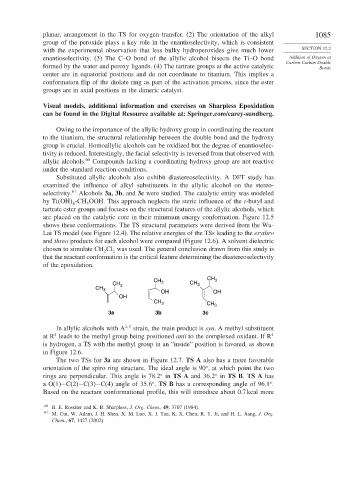Page 1109 - Advanced Organic Chemistry Part B - Reactions & Synthesis
P. 1109
planar, arrangement in the TS for oxygen transfer. (2) The orientation of the alkyl 1085
group of the peroxide plays a key role in the enantioselectivity, which is consistent
with the experimental observation that less bulky hydroperoxides give much lower SECTION 12.2
enantioselectivity. (3) The C–O bond of the allylic alcohol bisects the Ti–O bond Addition of Oxygen at
Carbon-Carbon Double
formed by the water and peroxy ligands. (4) The tartrate groups at the active catalytic Bonds
center are in equatorial positions and do not coordinate to titanium. This implies a
conformation flip of the diolate ring as part of the activation process, since the ester
groups are in axial positions in the dimeric catalyst.
Visual models, additional information and exercises on Sharpless Epoxidation
can be found in the Digital Resource available at: Springer.com/carey-sundberg.
Owing to the importance of the allylic hydroxy group in coordinating the reactant
to the titanium, the structural relationship between the double bond and the hydroxy
group is crucial. Homoallylic alcohols can be oxidized but the degree of enantioselec-
tivity is reduced. Interestingly, the facial selectivity is reversed from that observed with
allylic alcohols. 60 Compounds lacking a coordinating hydroxy group are not reactive
under the standard reaction conditions.
Substituted allylic alcohols also exhibit diastereoselectivity. A DFT study has
examined the influence of alkyl substituents in the allylic alcohol on the stereo-
selectivity. 61 Alcohols 3a, 3b, and 3c were studied. The catalytic entity was modeled
by Ti OH -CH OOH. This approach neglects the steric influence of the t-butyl and
4 3
tartrate ester groups and focuses on the structural features of the allylic alcohols, which
are placed on the catalytic core in their minimum energy conformation. Figure 12.5
shows these conformations. The TS structural parameters were derived from the Wu-
Lai TS model (see Figure 12.4). The relative energies of the TSs leading to the erythro
and threo products for each alcohol were compared (Figure 12.6). A solvent dielectric
chosen to simulate CH Cl was used. The general conclusion drawn from this study is
2
2
that the reactant conformation is the critical feature determining the diastereoselectivity
of the epoxidation.
CH
CH 3
CH 3 3 CH 3
CH 3 OH OH
OH
CH 3 CH 3
3a 3b 3c
In allylic alcohols with A 1 3 strain, the main product is syn. A methyl substituent
4
at R leads to the methyl group being positioned anti to the complexed oxidant. If R 4
is hydrogen, a TS with the methyl group in an “inside” position is favored, as shown
in Figure 12.6.
The two TSs for 3a are shown in Figure 12.7. TS A also has a more favorable
orientation of the spiro ring structure. The ideal angle is 90 , at which point the two
rings are perpendicular. This angle is 78 2 in TS A and 36 2 in TS B. TS A has
a O(1)−C(2)−C(3)−C(4) angle of 35 6 , TS B has a corresponding angle of 96 1 .
Based on the reactant conformational profile, this will introduce about 0.7 kcal more
60 B. E. Rossiter and K. B. Sharpless, J. Org. Chem., 49, 3707 (1984).
61
M. Cui, W. Adam, J. H. Shen, X. M. Luo, X. J. Tan, K. X. Chen, R. Y. Ji, and H. L. Jiang, J. Org.
Chem., 67, 1427 (2002).

